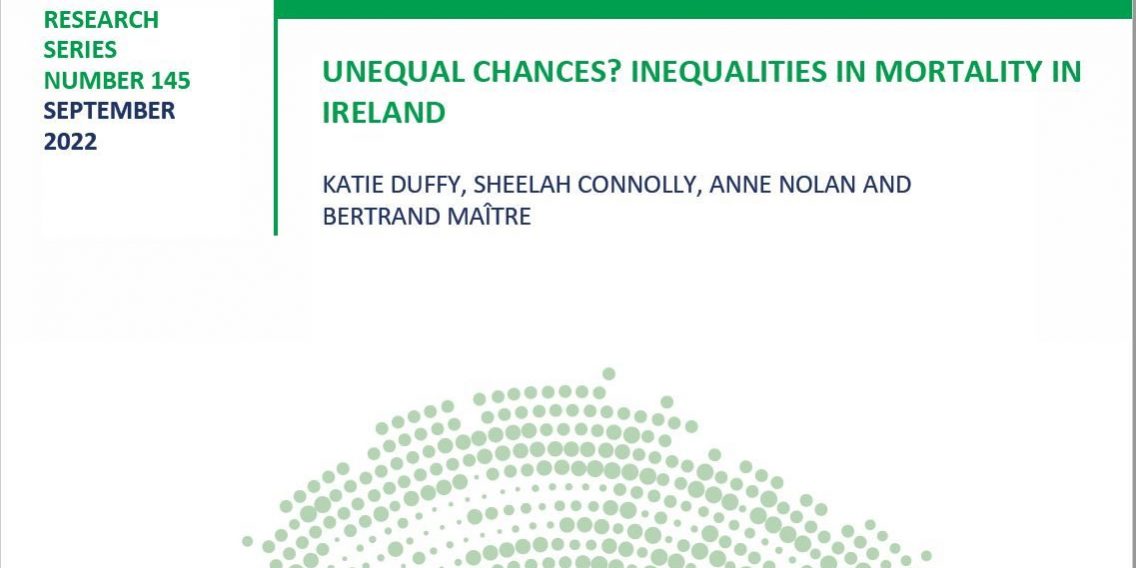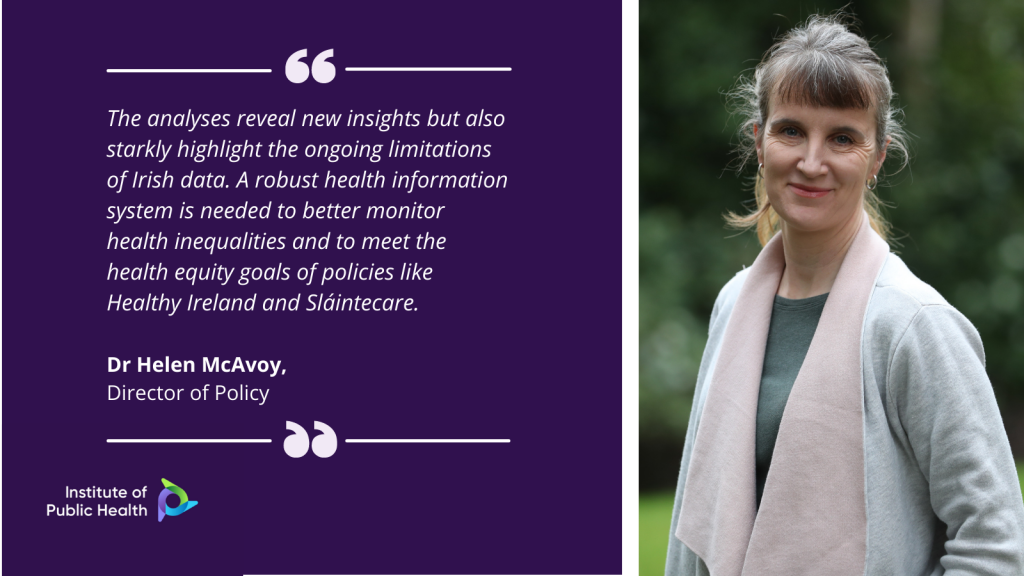
The Institute of Public Health (IPH) today welcomes the publication by the Economic and Social Research Institute (ESRI) of a new report on inequalities in mortality rates in Ireland.
IPH commissioned the ESRI to examine inequalities in mortality in Ireland between 2000-2019, with a focus on socio-economic status (SES) and, for the first time, assessing how ethnicity, place of birth, or nationality, may have a bearing on mortality rates and inequalities.
This new report, ‘Unequal Chances? Inequalities in Mortality in Ireland’, provides a timely update on IPH’s previous work in this area when it published a report in 2001 analysing all-Island mortality data between 1989-1998.

This new study found that overall mortality rates have fallen in Ireland since 2000 but that inequalities remain between different groups of the population.
Commenting on the findings, Anne Nolan, one of the authors of the ESRI report said: “Life expectancy and mortality are some of the most widely available indicators of population health and social progress. In addition to being unfair, inequalities in mortality across population groups are a key policy concern as they are potentially avoidable. Despite the overall improvement in mortality rates in Ireland in recent decades, the findings in this report highlight a number of groups that are vulnerable to higher mortality rates, and which require policy attention.”
IPH Director of Policy Dr Helen McAvoy said the ESRI report findings strengthened the case for better health data to support commitments to reduce health inequalities: “This report updates our understanding of how social and economic disadvantage can influence when and how people died in Ireland over the past decade. The analyses reveal new insights but also starkly highlight the ongoing limitations of Irish data. A robust health information system is needed to better monitor health inequalities and to meet the health equity goals of policies like Healthy Ireland and Sláintecare.”

Some key findings from the Unequal Chances report include the following:
Fewer deaths in the first week of life
The number of stillbirths and deaths in the first week of life per 1,000 births (known as the perinatal mortality rate) fell significantly between 2000 and 2019. This improvement was not experienced equally, the risk of death among babies born to mothers who were unemployed or mothers of African origin remained elevated over time. Previous analyses also show higher perinatal mortality in the Traveller Community. In 2019, the overall perinatal mortality rate, across all population groups, saw the first recorded increase since 2012.
Fewer deaths in the first year of life
Between 2000 and 2018, the infant mortality rate fell significantly (from 6.60 to 2.99 deaths per 1,000 infants). The gender gap decreased over time then disappeared, with boys and girls experiencing similar infant mortality in 2018 compared to the higher rate observed for boys in 2000. It was not possible to analyse socio-economic inequalities in infant mortality due to data deficits.
Fewer deaths in childhood
Between 2000 and 2018, the child mortality rate (deaths among children aged 1 to 14 years) fell significantly (from 0.17 to 0.08 deaths per 1,000 children). The gender gap decreased over time. It was not possible to analyse socio-economic inequalities in child mortality due to data deficits.
Inequality gap in mortality persists
The standardised mortality rate for those in the least advantaged socio-economic group was twice as high as those in the most advantaged group based on analysis of data from 2018. These inequalities translate into stark differences in life expectancy by socio-economic status. Life expectancy for males living in the most deprived areas of Ireland is five years shorter than those living in the least deprived areas (79.4 years versus 84.4 years).
Challenges to tracking trends in inequalities in mortality
Analysis of socio-economic inequalities in adult mortality in Ireland was hampered by data deficiencies.
An assessment of trends or changes in the causes of death that contribute to the inequality gap was not possible. Irish studies on adult mortality lack data on ethnicity, country of birth or nationality compared to studies published in the UK, Europe and the US. Ireland is generally excluded from European studies of inequalities in mortality due to data constraints.
Also, while socio-economic status was associated with higher age standardised mortality rates throughout the period, no assessment of trends could be made due to structural deficits in the way data was collected and coded in different time periods.
Inequalities in respiratory disease of real concern
In the period 2000 to 2012, people working in manual jobs were two times more likely to die of respiratory disease than people identified as employers and managers. High rates of respiratory mortality were observed in agricultural workers in this study.
Fewer deaths from circulatory disease and marginal fall in lung disease deaths
41% of deaths were caused by circulatory disease (heart disease and stroke) in 2000, falling to 29% of deaths in 2018. The proportion of deaths due to respiratory disease (conditions affecting the lungs) fell from 16% to 13% in the same time period.
Cancer overtakes circulatory disease as main cause of death
The proportion of adult deaths caused by cancer rose from 25% in 2000 to 30% in 2018. Around 6 in 10 deaths were caused by either cancer or circulatory disease in 2018.
Lower mortality rates in some ethnic groups
Analysis of adult mortality rates according ethnic and cultural background, country of birth and nationality revealed a substantially lower mortality rate in ethnic minority groups, as well as in those born outside Ireland or with non-Irish nationality. This may reflect a “healthy immigrant effect” whereby individuals migrating to Ireland are healthier on average than those in the destination country. Previous analyses, however, show higher mortality rates for adults in the Traveller Community.
Early evidence of inequalities in mortality from COVID-19 by socio-economic status
Although analyses were limited by data availability, there was evidence of a higher proportion of deaths from COVID-19 among people from lower socio-economic groups in the period May 2020 to May 2021. It is hoped that data from the COVID Data Research Hub will support further analyses on inequalities in COVID-19 mortality in Ireland. In those aged 65+ years, a higher share of COVID-19 deaths was observed among people born outside of Ireland and ethnic minority groups than might be expected given the size of the population.
Access the ‘Unequal Chances? Inequalities in Mortality in Ireland’ report here.


